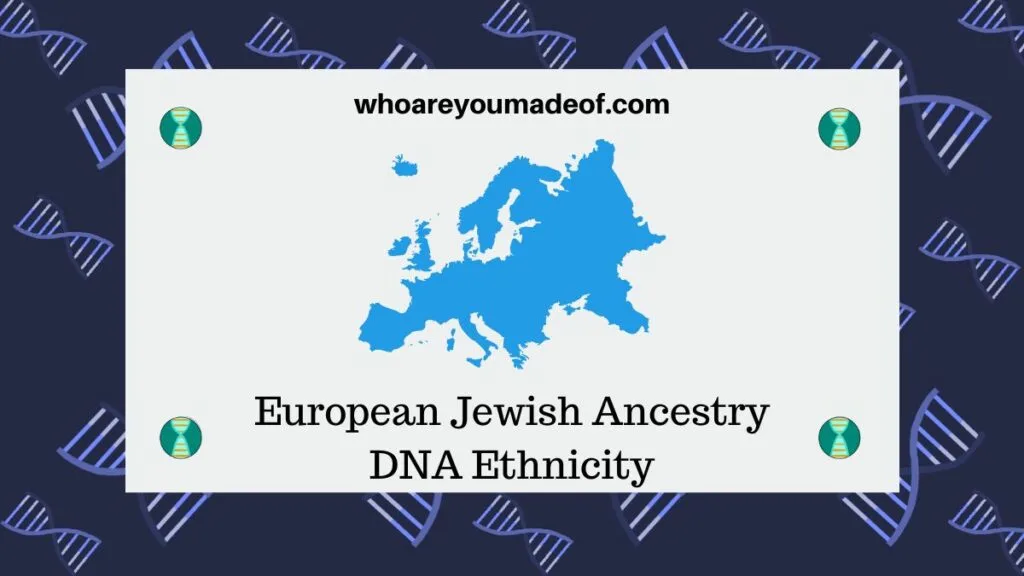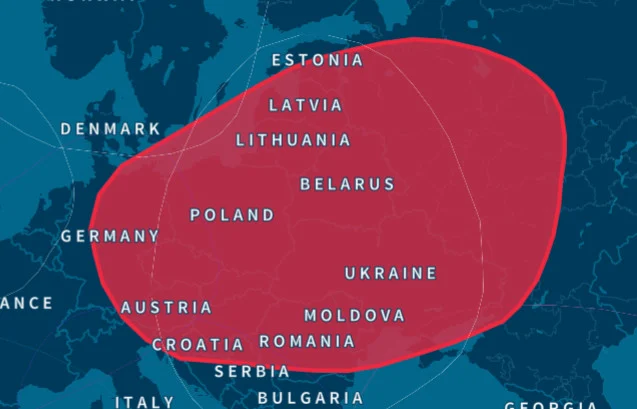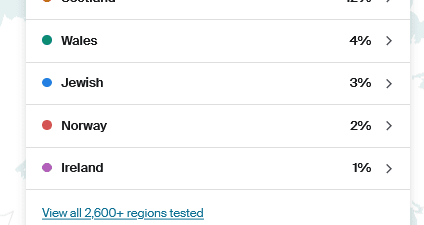If you just got your ethnicity results back from Ancestry DNA, you might be curious to learn more about the European Jewish DNA ethnicity. Even though it's fairly common for this to show up when someone has European ancestry, you might want to learn more.
In this post, I will explain what the European Jewish DNA ethnicity really is and how you might have inherited it. For many people, it's a surprise - and I'm glad you want to know more.

Who are the European Jews?
Many centuries ago, many Jews left the Middle East and moved gradually into other regions. Many of these Jews migrated across southern, central, and eastern Europe, though the exact path that they took during their migration is disputed.
What we do know is that these people were often the subject of mistreatment and discrimination in the local communities where they settled, and tended to live in relative isolation.
While some Jews were gradually absorbed into local cultures, and even converted to Christianity, many of the descendants of the Jewish migrants formed insular communities throughout Europe. These Jewish communities, formed primarily out of necessity, maintained not only culture and linguistic isolation, but also genetic isolation.
They rarely "admixed" with the local non-Jewish community. In fact, the typical native of a modern European Jewish community shows an average of 96% European Jewish DNA.
People who are native to these communities will often only show very small percentages of other European or Middle Eastern DNA ethncities.
The Jews who settled in Eastern and Central Europe are usually referred to as Ashkenazi Jews. This is a contrast to the Sephardic Jews, who are descended from Jews who settled in Spain, or the Mizrahi Jews who descend from those who remained in the Middle East.
Each population of Jews shares a unique genetic connection that can be detected by modern DNA testing techniques, which is why your testing company can tell you that you have European Jewish in your DNA.
Where is the European Jewish DNA ethnicity located?
The European Jews did not settle down in one small area, or even in one specific country. Instead, their communities are located throughout Europe. On the map below, you can visualize the large geographic area where European Jews are generally found:

European Jewish, or Ashkenazi, communities are primarily found in the following countries:
- Poland
- Belarus
- Ukraine
- Russia
- Hungary
- Israel
Large numbers of European Jewish people can also be found in these countries:
- Germany
- France
- Lithuania
- Latvia
- Slovakia
- Czech Republic
- Romania
- Bosnia
- Serbia
- Estonia
I was able to learn that my European Jewish DNA region came from my mother's side of the family. Using the Ancestry Ethnicity Inheritance by Parent, I was able to determine that my Jewish ancestry is on my mother's mother's side of the family.

If you don't have ancestors from any of the countries that I listed above, it's important to remember that humans are generally very mobile, and there were no doubt Ashkenazi Jews that ended up living in many places not listed.
For example, there are extensive Jewish communities in the United Kingdom, and France, and many of them were established hundreds of years ago. There are also many people of European Jewish descent living in Latin American countries, such as Mexico.
Some European Jewish immigrants to other countries assimilated into the local cultures, which makes it difficult for their descendants to research their Jewish ancestry.
Another reason that it is important to note the specific countries where European Jews are typically found is because many of these countries were devastated by the Holocaust. Millions of Jews and non-Jews from several of these countries were murdered.
Many of these people were related to those of us with Eastern European and European Jewish ancestry, and so we have fewer possible DNA cousins to locate. As an example in my own family, I'll share the story of my great-great grandfather who came to the United States with his brother.
My ancestor's brother was able to save up enough money to buy a small farm back in his country, so he went home, married, and started a family. Tragically, my relative's son and grandson were killed by the Nazis during World War II.
If you want to learn more about the other ethnicity regions on Ancestry DNA, make sure to check out my DNA Tools Page.
How did you get European Jewish DNA?
If you closely examine the list of countries where European Jewish communities are found, you will notice that we have had millions of immigrants from those countries settle in the United States.
The most common way that people in the United States (where most of my readers are from) inherited European Jewish DNA is from their German and Eastern European ancestors. I inherited mine from my German and Polish ancestors, for example.
Some people have small amounts of European Jewish show up on their ethnicity results, but have done extensive research and know that their family has been in the United States for many, many generations.
For example, I worked on a family tree for an elderly woman whose DNA showed 2% European Jewish, even though she had deep colonial roots on most lines in her family, and primarily English and Irish ancestry. Her most recent English ancestor was from a town in England, which coincidentally had a population of German-Jewish immigrants around the time that her great-great grandfather was born.
Perhaps even more interesting, the surname of her great-great grandmother was of Ashkenazi Jewish origin.
It should also be noted that many European Jews migrated to Palestine in large numbers, the majority as refugees, beginning in the 1880s, and had migrated their in smaller numbers prior to that time. "Aliyah" is an important concept in Judaism, and means "the act of going up" - in other words, going towards Jerusalem.
If you don't have any known European ancestors, it is worth considering that your European Jewish could trace back to part of the Jewish diaspora that migrated to Palestine at some point in the past.
As you can see, there are many ways that you could have inherited your European Jewish ancestry, and it will take some creativity as well as patience, in many cases, to figure out exactly where it came from.
Is it possible to trace your European Jewish ancestry?
In many cases, you will be able to trace your family history back far enough to find your European Jewish ancestor. The first steps are quite generic - you need to build a family tree, starting with you, your parents, and your grandparents.
Talk to them and get as much family history as possible. I can't stress the importance of this enough.
I always recommend building a family tree on Ancestry, since I also recommend their DNA testing service, and the combination of the two is a quite powerful research tool.
It's always free to build and access your family tree on Ancestry, but if you want access to the great records, you'll need a subscription.
If you want to give one a try to see if it works for you, you can get a free trial by using the following link. I'll get a small commission if you end up subscribing at the end of your free trial at no extra cost to you: Ancestry Free Trial
Obviously, for those of you who grew up Jewish, or know that your ancestors were Jewish, the following advice would not apply to your family tree research:
Once you get your basic tree built:
- Work back as far as you can on each line, carefully noting names, dates and locations
- Find documents that verify the lines you are researching
- Determine which countries your ancestors emigrated from
- Learn specific strategies for researching in those countries
- Try to determine the religion of your immigrant ancestors
There is a common misconception that Jewish records were destroyed during the Holocaust. While there was mass destruction, records were generally not destroyed, since these could used as proof of someone's Jewish ancestry.
But, even though many times there are records pertaining to your ancestors, finding them will not be easy.
The following are some good starting points, once you have a decent start on your family tree. Additionally, they will be helpful to those who already know how they inherited their European Jewish ancestry:
In some countries, the Christian Church was tasked with keeping track of births and deaths, even for local residents of other faiths. It's worth checking local church records to see if you can find records pertaining to your ancestors, even if you are sure they weren't Christian.
Conclusion
I hope that this post has helped you understand your European Jewish DNA ethnicity, how you might have inherited it, and the basics of how to trace your Jewish ancestry.
If you have any questions, comments, or would like to share your own experience in tracing your European Jewish ethnicity, please feel free to leave a note in the comments.
Thanks for stopping by!


Andrea Littleton
Saturday 6th of February 2021
My mom had her DNA tested with Ancestry. She is 2% European Jewish. We are fascinated because we had no idea. Is this a significant percentage? We want to research more but don’t even know where to begin!
AAmy A.
Sunday 23rd of August 2020
Great information, thank you. Another resource I have found useful for Jewish ancestors in some areas of Germany is the epigraphic database at the Steinheim Institute web site. A quick search will find it. It contains images and inscription translations for various Jewish cemeteries. Often there can also be a bio along with any dates from the tombstone. With only the name of a disowned GG grandmother who married out of the faith, DNA gave me a new cousin who had the name of her father. With the Steinheim database I was able to find parents, siblings etc in the bio of his father plus ancestors buried in the same cemetery. It also provided confirmation as it mentioned this particular son who emigrated from Bayreuth to America.
One question - does Jewish Gen have records not on ancestry? Or it just has all the Jewish related content from ancestry? I have come up empty handed on my GG grandmother's mother but do not want to duplicate record access I already have via ancestry or family search. Thank you.
Marilyn Dimsey
Tuesday 12th of May 2020
Hi, my Ancestry DNA shows 30% European Jewish 30% (Latvia,Lithuania,Belarus) and 49% England and Wales (Lancashire) +. 2 Others. Having explored my family tree I can only find the English/ Irish heritage! As I am 68 years old and have no older living relatives, is there any way of finding the answers? Many thanks.
Mercedes
Tuesday 12th of May 2020
Hi Marilyn, Thank you so much for your question. With 60% of your DNA coming from the European Jewish and Baltic States, I would suggest taking a look at your DNA matches who are related to you at a 4th cousin distance or closer, starting with your closet (top) matches. Examine the family trees and surnames of the matches, and you will likely spot a pattern that will lead you in the direction of this ancestry. Best of luck! Mercedes
Sharon JacobSharon Jacob
Tuesday 7th of April 2020
Thank you for this very informative article. I recently tested with a European Jewish line, an amazing surprise. Fortunately my cousin does our genealogy and had extensive records dating back to the 1700. It was a matter of looking to that century and there she was Eva Cohen. Since then whenever there are new matches to my dna there usually is a Jewish relative popping up. They all stem back to that 1700's relative. Amazing!
Mercedes
Thursday 9th of April 2020
Hi Sharon, Thank you for sharing this story! I'm so glad that you were able to identify your Jewish ancestry - it's wonderful to be able to connect to a name.